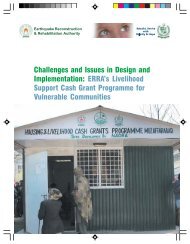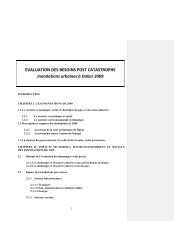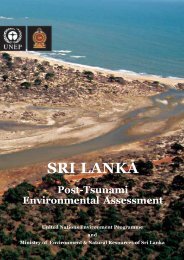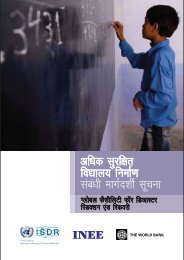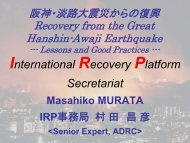post disaster reconstruction experiences in andhra pradesh, in india
post disaster reconstruction experiences in andhra pradesh, in india
post disaster reconstruction experiences in andhra pradesh, in india
- No tags were found...
You also want an ePaper? Increase the reach of your titles
YUMPU automatically turns print PDFs into web optimized ePapers that Google loves.
POST DISASTER RECONSTRUCTION EXPERIENCES IN ANDHRAPRADESH, IN INDIAAnnie Jayaraj *AbstractPost Disaster <strong>reconstruction</strong> work may be executed with a paternalistic,philanthropic approach as a project with an end <strong>in</strong> itself or with an approach,which is based on communities and as a means towards susta<strong>in</strong>able longtermdevelopment. The choice between these two depends on the <strong>in</strong>tentions,motivation, commitment, concepts, perceptions, capacities and character ofthe concerned NGO. ATMA consultancy services, render<strong>in</strong>g services to NGOs<strong>in</strong> South India for about 20 years wishes to share its <strong>experiences</strong> <strong>in</strong> thisregard. It is hoped that these <strong>experiences</strong> provide an <strong>in</strong>sight for the peoplewho are genu<strong>in</strong>ely <strong>in</strong>terested <strong>in</strong> address<strong>in</strong>g the issues relat<strong>in</strong>g to <strong>post</strong> <strong>disaster</strong><strong>reconstruction</strong> activities with special reference to hous<strong>in</strong>g.Community development; gender issues; non-governmental organizations; strategicplann<strong>in</strong>g; susta<strong>in</strong>able developmentTHE VULNERABILITY OF DISASTERS IN INDIAAccord<strong>in</strong>g to the Centre for Research on the Epidemiology of Disasters (CRED),Brussels, Belgium, India is the worst <strong>disaster</strong>-affected country <strong>in</strong> South Asia. CREDstudies show that between 1987 and 1996, on an annual average, <strong>disaster</strong>s killed5,063 people and affected 56,563,631 people <strong>in</strong> India. 2540 people died and392,690 people were affected by <strong>disaster</strong>s <strong>in</strong> 1997 alone. Estimation of theeconomic impact of natural <strong>disaster</strong>s (Average 1985-1995) is 1,645,507 million USdollars. CRED cautions that data on the f<strong>in</strong>ancial cost of <strong>disaster</strong>s is extremelydifficult to gather and verify. Lack of standards, accepted def<strong>in</strong>itions, documentationmechanisms make <strong>disaster</strong> data collection and collation a researcher’s nightmare <strong>in</strong>India.The National Center for Disaster Management, New Delhi reports that the number of<strong>disaster</strong>s <strong>in</strong> India has <strong>in</strong>creased 5 to 6 times <strong>in</strong> three decades and that the reliefprovided after <strong>disaster</strong>s was Rs.61.5 millions <strong>in</strong> the second f<strong>in</strong>ance commission androse up to Rs.14, 000 millions dur<strong>in</strong>g the 10 th f<strong>in</strong>ance commission.Due to globalization and consequent structural adjustment programmes, poverty,urbanization, environmental degradation, social dis<strong>in</strong>tegration, terrorism,* Programme Manager, ATMA Consultancy Services, TF2, Aasha Apartments, Loyola Gardens,Vijayawada – 520 008 A.P., INDIA
communalism, deforestation, global warm<strong>in</strong>g, pollution, <strong>in</strong>dustrial <strong>disaster</strong>s, etc., thehuman made <strong>disaster</strong>s are also expected to <strong>in</strong>crease <strong>in</strong> the near future.Andhra Pradesh: The most Disaster Prone State <strong>in</strong> IndiaAndhra Pradesh is the most Disaster prone area <strong>in</strong> terms of drought, floods,cyclones and fire. It is the fifth largest state <strong>in</strong> India, <strong>in</strong> terms of both population andarea. Spread over 2.75 lakh sq km, it comprises 8.4 per cent of the country's totalgeographic area. It has a long coastl<strong>in</strong>e stretch<strong>in</strong>g approximately 1,030 km, and anequally long history of cyclones. It is battered by at least one cyclone per year. Thecoastl<strong>in</strong>e districts are normally affected by cyclones and floods, whereas the westernand northern parts of Andhra Pradesh often experience severe drought conditionsDisaster ManagementDisasters are both natural and human made – a battery of floods, droughts,cyclones, land slides, earthquakes, communal riots, armed conflicts, fires, volcaniceruptions and epidemics and <strong>in</strong>dustrial <strong>disaster</strong>s (Bhopal Gas Tragedy). Themagnitude of <strong>disaster</strong>s is documented by reference to the degree of vulnerability ofthe affected population.Disaster Management should not be seen <strong>in</strong> isolation but various phases ofmanagement <strong>in</strong> address<strong>in</strong>g this particular issue i.e. <strong>in</strong> the form of preparedness,relief, rehabilitation mitigation and <strong>reconstruction</strong>.Many organizations are <strong>in</strong>volved <strong>in</strong> relief and rehabilitation. Most often the focus onpreparedness, mitigation and <strong>reconstruction</strong> rema<strong>in</strong> neglected. It is necessary fororganizations, which are concerned about <strong>disaster</strong> to address various stages of<strong>disaster</strong> management.Different phases of Disaster ManagementPreparedness Disaster Event ReliefMitigation Reconstruction Rehabilitation
Disaster MitigationMitigation means, “actions taken to reduce risks”. It means a pro-active and apreventive measure. It is cost effective, long-term result oriented. It contributes toprotect<strong>in</strong>g lives, property and the development process. The mitigation measurestaken <strong>in</strong> advance can reduce the impact of <strong>disaster</strong> on people and the environment.Strengthen<strong>in</strong>g of unsafe build<strong>in</strong>g may be considered as physical mitigation.Legislation, tra<strong>in</strong><strong>in</strong>g, educational measures for public awareness, soil conservation,reforestation, etc., are some of the ways to reduce the <strong>disaster</strong>s by anticipatoryactions and this may be termed as non-structural mitigation. Introduc<strong>in</strong>g appropriatecrops and breeds of livestock’s, drought resistance practices, etc., which are aimedto withstand the impact of <strong>disaster</strong> may be measured as agricultural mitigationmeasures.It is necessary to mention here that after the cyclone of November 1996 <strong>in</strong> AndhraPradesh. The technical expert team made the on-the-spot assessment and madeeight recommendations to mitigate the extent of damage caused to the build<strong>in</strong>gs <strong>in</strong>the cyclone prone areas and they are available on request.Disaster PreparednessDisaster preparedness means predict<strong>in</strong>g, respond<strong>in</strong>g to and cop<strong>in</strong>g with the effectsof a <strong>disaster</strong> through plann<strong>in</strong>g and preparation, such as tra<strong>in</strong><strong>in</strong>g <strong>in</strong> evacuation andsett<strong>in</strong>g up systems to operate <strong>in</strong> emergencies. There is a close relation betweenmitigation and preparedness. However, the broad dist<strong>in</strong>ction between the tworelates to the essential difference between short and long term factors.Preparedness plann<strong>in</strong>g deals more with the short term and is concerned with thedevelopment of an orderly and systematic approach to deal with <strong>disaster</strong> <strong>in</strong> such away as to m<strong>in</strong>imize casualties and further damage. This covers a number of specifictasks, such as establish<strong>in</strong>g an emergency operations center, stockpil<strong>in</strong>g ofemergency supplies, mak<strong>in</strong>g an evacuation plan for a community liv<strong>in</strong>g near apossible source of flood<strong>in</strong>g, etc.RehabilitationThe rehabilitation phase follows next and <strong>in</strong>volves actions taken <strong>in</strong> the weeks andmonths follow<strong>in</strong>g a <strong>disaster</strong> to restore basic services to enable the affectedpopulation to return to pre <strong>disaster</strong> conditions.Relief <strong>in</strong> Disaster ManagementAs many NGOs, <strong>in</strong>stitutions, etc., are <strong>in</strong>volved <strong>in</strong> relief operation, it is felt necessaryto deal with this subject appropriately, based on the past <strong>experiences</strong>.
The role of relief though is short term, and is one of the most important humanitarianacts dur<strong>in</strong>g <strong>disaster</strong>s. But it requires tra<strong>in</strong>ed, dedicated team with lot of discipl<strong>in</strong>e,dedication, determ<strong>in</strong>ation and duty-bound <strong>in</strong> direct<strong>in</strong>g the relief operations and if it isnot managed effectively, this itself ends up <strong>in</strong> <strong>disaster</strong>. Usually there is tremendousresponse to a <strong>disaster</strong> with<strong>in</strong> the community, neighborhood, philanthropicorganizations, NGOs, their networks and also at the national and <strong>in</strong>ternational levelsdepend<strong>in</strong>g on the nature and magnitude of the <strong>disaster</strong>. If the relief that comes outof such a response is not properly handled to ensure that it reaches the deserv<strong>in</strong>gand needy, it results <strong>in</strong> embezzlement, disappo<strong>in</strong>tment, frustration, distress, etc.Division of work, time management and teamwork are very crucial dur<strong>in</strong>g rescue andrelief operations. It is necessary to see that the follow<strong>in</strong>g unhealthy practices are notperformed dur<strong>in</strong>g relief:• More than needed relief reaches the easily accessible areas, those areas whichreceive good press /TV coverage and the far-flung villages across bodies ofwater get little or no relief material.• Political leaders with vested <strong>in</strong>terest divert the material to their areas and misusethem.• Local leaders - those who are concerned about their communities - mismanagethe work.• More remote <strong>in</strong>accessible and marg<strong>in</strong>alized areas which don’t have anyresources, and who cannot articulate their feel<strong>in</strong>gs, are often worst affected butthey are neglected, uncared for and taken for granted.• Dur<strong>in</strong>g immediate relief, when medical care and the enumeration process occur,it is the economically better off and assertive sections that benefit most.• Initially, most of the organizations <strong>in</strong>volved follow a populist approach and makemost emotional promises without a match<strong>in</strong>g performance• Government resources are usually meager to meet the needs and they do notfollow equity pr<strong>in</strong>ciples but distribute relief equally. The staff is most oftenuntra<strong>in</strong>ed, unprofessional, not sensitive to issue, gives importance to presscoverage and succumbs to political pressures.Some of the tips that deserve to be followed dur<strong>in</strong>g relief operations are out l<strong>in</strong>edbelow:‣ Education of the public regard<strong>in</strong>g the government relief available, throughpamphlets giv<strong>in</strong>g <strong>in</strong>formation regard<strong>in</strong>g the various relief measures announcedby the government.‣ Document compla<strong>in</strong>ts for presentation to the authorities. A volunteer team toregister compla<strong>in</strong>ts that are represented <strong>in</strong> person, through <strong>post</strong> or by phone andfollow it up.‣ Organize volunteers’ task force <strong>in</strong> important government offices like the RDOoffice, MRO office, Panchayat office, Government hospital, where people comewith compla<strong>in</strong>ts and help them with guidance, assistance and organize proteststo achieve results.
‣ Run a mobile cell, which visits the villages to enquire if people are gett<strong>in</strong>g therelief, medical care, basic needs etc.‣ Motivate NGOs with <strong>in</strong>formation, material and expertise to be efficient andeffective <strong>in</strong> their <strong>in</strong>terventions.‣ Ensure proper enumeration of families, who need relief and rehabilitation.‣ Organize public hear<strong>in</strong>gs for address<strong>in</strong>g issues of that need public attention,support and solidarity actions.‣ Organize and coord<strong>in</strong>ate the relief operations.‣ Prevent out break of epidemics etc.Post Disaster ReconstructionFollow<strong>in</strong>g on the rehabilitation phase is the <strong>reconstruction</strong> phase. This phaseprovides an opportunity to <strong>in</strong>troduce new modes of organiz<strong>in</strong>g a community andreduc<strong>in</strong>g vulnerability to hazards.The <strong>reconstruction</strong> is a rebuild<strong>in</strong>g measure and that is applicable after certa<strong>in</strong><strong>disaster</strong>s. The <strong>reconstruction</strong> <strong>in</strong>volves build<strong>in</strong>g the confidence, self-respect, selfesteem,self-dependency, mutual support, and mutual trust and rebuild<strong>in</strong>g ofcommunities. This is a long-term process and it focuses more on human andmaterial resource development, coord<strong>in</strong>ated effort towards <strong>in</strong>dependence,susta<strong>in</strong>ability and empowerment. In this “Reconstruction” the most vulnerable andmarg<strong>in</strong>alized sections like women, children, poorest section of society, etc., are theprimary stakeholders and partners <strong>in</strong> the empower<strong>in</strong>g process.Based on the <strong>experiences</strong> of ATMA Consultancy Services <strong>in</strong> the <strong>reconstruction</strong>work, several pr<strong>in</strong>ciples and best practices <strong>in</strong> Post Disaster Reconstruction Workhave been identified and they are listed below.• The <strong>reconstruction</strong> work should be community managed, controlled and owned,socially and culturally acceptable. It should promote mutual support of thecommunities, enlist self-help and ensure voluntary labor.• The locally exist<strong>in</strong>g ecologically friendly, low cost materials should be made useof. All the available local resources, local talents, subsidies and various schemesof the governments should be made use of.• Simple, latest, cost effective, research based technology and <strong>in</strong>digenoustechnology that is easily adaptable and ma<strong>in</strong>ta<strong>in</strong>able must be preferred.• Efforts should be made to make use of the old and useful build<strong>in</strong>g materials andthereby avoid<strong>in</strong>g wastage and m<strong>in</strong>imize the cost of construction.• The labor <strong>in</strong>tensive technology should be encouraged and mechanization ofconstruction and labor displac<strong>in</strong>g technology should be opposed and discourage.• The programme should facilitate skill development, up-gradation of traditionalskills and encourage learn<strong>in</strong>g by do<strong>in</strong>g. It should encourage and make use of thematerials produced by village <strong>in</strong>dustries and rural artisans.
The <strong>reconstruction</strong> should foster feel<strong>in</strong>gs of solidarity and barga<strong>in</strong><strong>in</strong>g capacities, andaddress the issues related to rights and entitlements and strive for collective growth.The partners of this <strong>reconstruction</strong> process, irrespective of their position and status,must work for transparency accountability, democratization, capacitation andcollective growth, and steer the community to manage a controlled, self-owned andsusta<strong>in</strong>ed development process through effective organizational and projectmanagement systems and procedures.Many NGOs, government mach<strong>in</strong>eries, and representatives of the communities, whobelong to higher strata or middle class, are clueless and don’t have sufficientmotivation and commitment <strong>in</strong> address<strong>in</strong>g the problem of the most marg<strong>in</strong>alizedcommunities. Dur<strong>in</strong>g any <strong>disaster</strong>, it is mostly women and children, elderly anddisabled, who become the most vulnerable victims and therefore any <strong>reconstruction</strong>work, should address the issues related to women and children.It is our experience that if the issues related to women are properly addressed,issues related to children are taken care of. As the women sector belong to amajority of potential partners, as a matter of pr<strong>in</strong>ciple and <strong>in</strong> practice the genderconcerns and women issues must be addressed effectively <strong>in</strong> the Reconstructionwork.Address<strong>in</strong>g the <strong>post</strong> <strong>disaster</strong> <strong>reconstruction</strong> work with gender perspectivePrior to address<strong>in</strong>g the issues of women, it is necessary to dist<strong>in</strong>guish the differencebetween the often confused and mis<strong>in</strong>terpreted concepts of sex and gender. Itshould be noted that sex is biological, whereas gender is a social construct. It iswith the gender perspective that the issues affect<strong>in</strong>g women should be addressed.However, from experience, it is observed that this is more easily said than done.There is also a tendency to overburden women <strong>in</strong> the name of women development,women empowerment and gender concerns. Though, there are limited <strong>experiences</strong><strong>in</strong> address<strong>in</strong>g the issues, it is of paramount importance to share them with a hopethat many more <strong>in</strong>itiatives will be undertaken based on our experience and on thereality.Usually at the time of cyclones and floods, the people liv<strong>in</strong>g <strong>in</strong> low-ly<strong>in</strong>g areas, onthe banks of rivers or other encroached lands are affected and it is they who lose lifeand property. Dur<strong>in</strong>g rehabilitation, such people are shifted to safer places andpermanent houses provided <strong>in</strong> such new and safe areas. In such circumstances, itis necessary to se that the new allotment of house sites is registered <strong>in</strong> the name ofwomen.Sometimes though, the people are liv<strong>in</strong>g <strong>in</strong> safer places but <strong>in</strong> non-permanenthouses like thatched houses; when their houses are lost <strong>in</strong> a cyclone, rehabilitationtakes the form of provid<strong>in</strong>g permanent houses at the same place. In such cases, itis necessary to <strong>in</strong>sist that the land rights <strong>in</strong> the name of men are converted <strong>in</strong>to jo<strong>in</strong>townership of men and women before the permanent houses are constructed.
S<strong>in</strong>gle women (like widows, unmarried majors, divorcees, deserted women etc.,)should be treated as separate and <strong>in</strong>dependent units for the purpose ofdevelopmental <strong>in</strong>terventions and all rehabilitation measures.In issues related to evolv<strong>in</strong>g policies, constitut<strong>in</strong>g committees, elect<strong>in</strong>g bodies,selection of staff, decision mak<strong>in</strong>g structures, as a rule not less than 50% of womenrepresentation must be ensured.The perspectives and real needs of women should form part of all plans and projectproposals.Prior to support<strong>in</strong>g the projects for <strong>reconstruction</strong> and on long term developmental<strong>in</strong>terventions, the Community Based Organizations (CBOs), the <strong>in</strong>termediary NGOsand the sponsors of the programmes should ensure that more specific guidel<strong>in</strong>esare applied with specific gender focus <strong>in</strong> plann<strong>in</strong>g and implementation of theprogramme. As a concrete measure, it is strongly recommended that all benefit<strong>in</strong>gcommunities are asked to sign an MOU with Do’s and Don’ts as a code of conduct <strong>in</strong>address<strong>in</strong>g the concerns of women and girls. For example, these can cover issuessuch as shar<strong>in</strong>g of domestic work, prevent<strong>in</strong>g child marriages, send<strong>in</strong>g the girls toschool, promotion of women as community leaders, strengthen<strong>in</strong>g the economic<strong>in</strong>dependence of women, measures to check dowry, wife batter<strong>in</strong>g, sexual abuse,forced marriages etc.In other words, there need to be special <strong>in</strong>itiatives for address<strong>in</strong>g the practical andstrategic needs of women. Specific measures should be undertaken to <strong>in</strong>itiate,promote, support and susta<strong>in</strong> women leadership <strong>in</strong> social, economic and politicalfronts.Of late, various developmental programmes have been <strong>in</strong>itiated with specific focuson women, which makes women more responsible, burdened with more work andless control over the benefits. Hence, the <strong>reconstruction</strong> and long termdevelopmental measures should ensure that appropriate activities, strategies and<strong>in</strong>dicators are evolved to monitor the advancement of women <strong>in</strong> various sectors andmen should become collaborators <strong>in</strong> this process.A Few Experiences <strong>in</strong> Post Disaster Reconstruction <strong>in</strong> Andhra PradeshNASA’s Post Reconstruction Hous<strong>in</strong>g Programme for Empower<strong>in</strong>g UntouchableDalits and marg<strong>in</strong>alized Women:NASA’s chief bureaucrat has immense experience <strong>in</strong> relief and rehabilitation and forNASA, relief and rehabilitation work provides an opportunity to organize thecommunities towards the goal of dalit empowerment. Floods, cyclones, fireaccidents and atrocities on dalits – all provide the entry po<strong>in</strong>t and as a means toconsolidate people organizations towards susta<strong>in</strong>able development andempowerment. NASA demonstrated this <strong>in</strong> its relief and rehabilitation work after
Locally available resources1990, 1995 and 1996 cyclones. In the <strong>reconstruction</strong> work after these cyclones,NASA utilized the emotional situations to foster unity among dalits and <strong>in</strong>spire themto build their own future. Hous<strong>in</strong>g provides the best opportunity for such acommitted community organization work. The people’s organizations are motivatedto complete the project by <strong>in</strong>troduc<strong>in</strong>g locally feasible cost effective technology,participative, transparent and accountable systems. NASA made use locallyavailable resources for hous<strong>in</strong>g such as bricks, rough stones, sand, deadwood etc.,to the optimum level. NASA has so far constructed more than 8,000 permanenthouses. So far 18,000 acres of land was acquired and developed with special focuson watershed management and by <strong>in</strong>troduc<strong>in</strong>g appropriate land developmentpractices. This has immensely contributed to the socio-economic advancement ofthe dalits. NASA’s documents showed that it has promoted 5,000 self-help groupsrang<strong>in</strong>g from 10 to 15 members per group and there are 60,000 women <strong>in</strong>volved.They are federated at the macro level as cooperative societies. They are <strong>in</strong>volved<strong>in</strong> sav<strong>in</strong>gs, credit, skill development, and <strong>in</strong>come generation and as activeparticipants <strong>in</strong> socio-economic and political empowerment processes.The concept of hous<strong>in</strong>g does not end with the completion of houses. The unity and‘we’ feel<strong>in</strong>g developed dur<strong>in</strong>g the hous<strong>in</strong>g programme motivated people to acquireland and develop it, mobilize programmes for basic and m<strong>in</strong>imum needs, schools,<strong>in</strong>come generat<strong>in</strong>g programmes and strengthens unity to fight for self respect anddignity.Land Development
The hous<strong>in</strong>g colonies are provided with good <strong>in</strong>ternal roads, community halls,dra<strong>in</strong>age, smokeless chullahs, com<strong>post</strong> pits, electrification, dr<strong>in</strong>k<strong>in</strong>g water, schools,kitchen gardens, flower gardens, etc. The kitchen gardens with coconut plants yield<strong>in</strong>come. The permanent houses with hygienic atmosphere has brought new statusand dignity to the dalits, the so called untouchables, who live <strong>in</strong> segregated areas. Itis not an exaggeration to say that the newly built dalit colonies give a better lookthan the hous<strong>in</strong>g colonies of the dom<strong>in</strong>ant castes.Pre Reconstruction Scenario of DibbulapalemDibbulapalem is slum on the banks of Thandava River <strong>in</strong> a low-ly<strong>in</strong>g area. There areabout 70 families. This colony was branded as a sex workers colony and allgovernmental agencies and the public neglected it. The majority of them wasilliterate and their children were sent to cashew factories as labourers.Brick Mak<strong>in</strong>gThe cyclone of 1995 was devastat<strong>in</strong>g and it washed away all the thatched houses ofDibbalapalem. The residents lost all their belong<strong>in</strong>gs and were left bare. At thisjuncture NASA stepped <strong>in</strong>to the Dibbalapalem colony and started an awarenesscampaign and conducted health camps. All women were organized as WomenSangham and they were successfully persuaded to abandon prostitution. NASAhelped the women’s Sangham to mobilize and solicit a grant from the governmentfor hous<strong>in</strong>g and the grant from the Emergency Desk of Diakonisches Werk was alsorequested. NASA facilitated the construction of 74 houses with the activeparticipation of the women’s organization, which organized its own brick mak<strong>in</strong>g unit,mobilized voluntary labour, monitored the construction, <strong>in</strong>troduced cost controlmeasures. The title deeds of the houses were obta<strong>in</strong>ed <strong>in</strong> the name of the women.Hous<strong>in</strong>g brought a tremendous change <strong>in</strong> the lives of the women. They werecounseled and motivated to save regularly and helped to mobilize match<strong>in</strong>g grantsfrom the government to take up alternative forms of liv<strong>in</strong>g like micro-bus<strong>in</strong>esses.The children were guided to get admission <strong>in</strong>to Government schools and <strong>in</strong> NASA’schild labour schools. After completion of the houses, the Sangham mobilizedgovernment support for <strong>in</strong>ternal roads, community hall, electricity and developedkitchen gardens <strong>in</strong> next the houses. With permanent houses and beautiful roads,the hitherto slum now gives a posh look. The bad name for the locality also got
erased over years. Some of the women converted part of their houses, fac<strong>in</strong>g thema<strong>in</strong> road, <strong>in</strong>to shops.The spirit and motivation that propelled hitherto sex workers to transform themselves<strong>in</strong>to dignified citizens was possible through an effective organizational network. Thisbrought assertiveness among them and a desire to a lead <strong>in</strong> the democratic process.The women participated <strong>in</strong> local municipal elections and got one candidate electedas councilor for their area and also cornered the chairperson’s <strong>post</strong> to theircandidate.Reconstruction of Houses: The Experience with TWACHARDOThe worst cyclonic <strong>disaster</strong> <strong>in</strong> the recent memory <strong>in</strong> the country occurred <strong>in</strong> 1977 <strong>in</strong>Guntur and Krishna districts, Andhra Pradesh, due to tidal waves. More than 10,000people perished overnight, mak<strong>in</strong>g it the biggest national calamity. The governmentwas strongly criticized for its failure <strong>in</strong> relief and rescue operations and <strong>disaster</strong>preparedness. Innumerable human and material resources were mobilized byvarious bodies for relief and <strong>reconstruction</strong>. The present experience relates to onesuch village, called Pallipalem, <strong>in</strong>habited by 70 fishermen families, which is just 2kmfrom the Bay of Bengal, where a private company came forward to reconstruct thehouses and the State adm<strong>in</strong>istration constructed a cyclone shelter.In 1990 there was another cyclone of even larger magnitude and the majority ofthose houses were damaged. TWACHARDO requested Diakonisches Werk,Germany, for f<strong>in</strong>ancial support to take up <strong>post</strong>-<strong>disaster</strong> <strong>reconstruction</strong> work. On-thespotassessment proved that the pre-fabricated concrete roofs were of poor qualityand they were already unfit for liv<strong>in</strong>g. People built up temporary shelters withcoconut leaves and were liv<strong>in</strong>g there. The cyclone shelter of a comparatively bigsize with two floors was not ma<strong>in</strong>ta<strong>in</strong>ed and was <strong>in</strong> a dilapidated condition. As noone was responsible for the build<strong>in</strong>g, people were us<strong>in</strong>g it for gambl<strong>in</strong>g, a portion ofit was used for storage and at nights it was used for immoral acts. There were aboutsix toilets meant for the community <strong>in</strong> a row out of which four were locked and thetwo were used for stor<strong>in</strong>g some household items. In the same premises, there wasa school and the children had to go for open-air defecation. It was also found outthat the government has given two acres of land, which were under the threat ofoccupation by non-local affluent section. The village was exposed to sea withoutanyth<strong>in</strong>g to prevent cyclonic storms or w<strong>in</strong>ds. The fish<strong>in</strong>g boats and nets of thepeople were <strong>in</strong> a damaged condition.In view of the above scenario a comprehensive plan to address all the issues wasplanned with the active participation of the people, NGO, the State Hous<strong>in</strong>gcorporation and district adm<strong>in</strong>istration. Their f<strong>in</strong>ancial commitments were obta<strong>in</strong>ed<strong>in</strong> writ<strong>in</strong>g. The NGO and the community were facilitated to enter <strong>in</strong>to a written MOUon their roles and responsibilities. With the support of the Emergency Desk ofDiakonisches Werk, the Andhra Pradesh State Hous<strong>in</strong>g Board, the districtadm<strong>in</strong>istration, the local government and Andhra Bank, coupled with the people’s
contribution <strong>in</strong> the form of labor, by us<strong>in</strong>g the salvaged doors and w<strong>in</strong>dows from thebuild<strong>in</strong>gs and by us<strong>in</strong>g resources to the optimum, they could execute all theprogrammes that were planned. In the process, the people had to face somedifficulties. The ma<strong>in</strong> difficulty was the traditional NGO attitude of the ChiefBureaucrat, who was not really promot<strong>in</strong>g people’s participation, which had to beovercome. Another difficulty was that of the government officials, who expected toreceive certa<strong>in</strong> percentages from the benefits extended by the government. Boththese difficulties could be over come by the <strong>in</strong>tervention of the consultant ofDiakonisches Werk, who took precautions to actively <strong>in</strong>volve people and maketh<strong>in</strong>gs transparent, democratic and participatory.Ultimately, the planned goals could be achieved and people successfully completedthe hous<strong>in</strong>g, repaired the cyclone shelter and the community took responsibility forits proper use and ma<strong>in</strong>tenance. The community organization became spirited andmotivated and they proceeded to acquire the lands allotted to them for cultivation.As the NGO did not have the capacity to organize the people to struggle for rightsand facilitate further development, it could not make full progress soon after thewithdrawal of services by consultants.BREDS and the SHGs as well as MACS grow stronger <strong>in</strong> partnership towardssusta<strong>in</strong>able developmentBREDS provides an <strong>in</strong>spir<strong>in</strong>g illustration where people’s <strong>in</strong>itiative and participationwas at its optimum. BREDS, which works among the rural poor of Kottur Mandal,Srikakulam district of Andhra Pradesh, is composed of young, enthusiastic and<strong>in</strong>novative board members and staff. This young group <strong>in</strong>spired by ideals ofvoluntarism <strong>in</strong> its true spirit <strong>in</strong>troduced totally transparent, accountable, democratic,participative systems <strong>in</strong> to the people’s organizations, which <strong>in</strong> turn motivated thepeople to actively shape their own dest<strong>in</strong>ies. The staff and people addressed theissues of fire mishaps <strong>in</strong> the hous<strong>in</strong>g colonies, floods and drought that followedsuccessively one after another <strong>in</strong> 1996. They have decided to go for permanenthous<strong>in</strong>g and constructed about 200 houses with people’s participation at its peak.The people contributed voluntary labor as a community to complete the entirehous<strong>in</strong>g with<strong>in</strong> record time <strong>in</strong> a most cost effective way by mobiliz<strong>in</strong>g all localresources like sand, wood and manufactur<strong>in</strong>g bricks. Cement was purchaseddirectly from the manufacturers, thereby sav<strong>in</strong>g a lot. The CBO model with highlevel of people participation has reached such a level that BREDS gave away itsoffice to the CBO and the process of withdrawal of NGO and takeover by CBO is <strong>in</strong>its full sw<strong>in</strong>g. Shortly, it is hoped that the CBO will take over the staff of BREDS.The model work of CBO has attracted the attention of the District Adm<strong>in</strong>istration,which has come forward to sanction not only all possible schemes to the people but,all government works <strong>in</strong> the area also are given to the community, which works forthe larger benefit of the community. The people have successfully implemented andbenefited through various programmes like tree plantation and afforestation of hillslopes, land development, weav<strong>in</strong>g schemes, women development schemes, roadand tank works, fish cultivation, etc., and all these measures resulted <strong>in</strong> controll<strong>in</strong>g
out-migration for paid labour. A few hundred SHGs of women’s federations becamethe cooperative society, which takes care of the staff of BREDS as their employeesand replaced the NGO and march<strong>in</strong>g ahead as a mandal.Community Based Organization-Meet<strong>in</strong>gPost Reconstruction – Another Experience of DisasterThere were flash floods <strong>in</strong> a traditionally drought prone area of Cuddapah district <strong>in</strong>Andhra Pradesh.<strong>in</strong> October, 1996 due to poor ma<strong>in</strong>tenance of m<strong>in</strong>or irrigation tanks,floodgates of a reservoir.A few <strong>in</strong>ternational donors promptly responded with relief and rehabilitation work. Anetwork of 15 NGOs <strong>in</strong> the district that is associated with a jo<strong>in</strong>t forest managementproject, implemented the above project <strong>in</strong> cooperation with the government and localcommunities.In one site, it was planned to rehabilitate about 1000 Dalit families from 15 villages.They were not only affected by floods but also their villages were located under thesubmerg<strong>in</strong>g area of Somaseela reservoir; they are to be relocated. For suchdisplaced persons, there was altogether a different and better package than that ofother rehabilitation programmes.The work started off well. Two NGOs were entrusted with responsibilities forconstruct<strong>in</strong>g 1000 houses. The support of one western donor was used to layfoundation work. Another western donor helped one of the NGOs with support forbuy<strong>in</strong>g four cement brick mak<strong>in</strong>g mach<strong>in</strong>es and implements for land developmentwork, the government assigned about 1500 acres of land for the families to berelocated and to buy Cuddapah slab stones for roof terrac<strong>in</strong>g.The issues were that the people would not leave from their exist<strong>in</strong>g villages becausethey feared that compensation would not be given, if they shifted their residences.
Secondly they have to depend on their daily labour to eke out a liv<strong>in</strong>g and <strong>in</strong> the newsettlement - unless and until the land development and jo<strong>in</strong>t forest managementprogrammes were taken up - they would not be able to f<strong>in</strong>d employment. They havealso found it difficult to travel 20 kms up and down by spend<strong>in</strong>g about one day’swage for a day’s travel expenses so that it proved to be difficult to participate <strong>in</strong> theconstruction work.One of the NGOs created employment for about 20 people to make cement bricksand to transport sand and other build<strong>in</strong>g materials. This however, could not becont<strong>in</strong>ued because the employees of Andhra Pradesh Hous<strong>in</strong>g Corporation and theChief Bureacrats of the NGOs had their own agenda <strong>in</strong> the absence of people’sparticipation. The government employees hired the brick mak<strong>in</strong>g mach<strong>in</strong>es andproduced poor quality of bricks and used <strong>in</strong>ferior quality of build<strong>in</strong>g materials. Thegovernment employees, who were expected to monitor the progress, took up the jobof construction much aga<strong>in</strong>st the norms and rules laid by the Hous<strong>in</strong>g Corporation <strong>in</strong>collision with higher ups. In purchas<strong>in</strong>g materials, <strong>in</strong> masonry work, <strong>in</strong> lay<strong>in</strong>g <strong>in</strong>ternalroads, <strong>in</strong> s<strong>in</strong>k<strong>in</strong>g bore wells, <strong>in</strong> mak<strong>in</strong>g build<strong>in</strong>g materials and <strong>in</strong> every other field,wherever they were <strong>in</strong>volved, they made their profit by bypass<strong>in</strong>g the ethics,pr<strong>in</strong>ciples, etc. Three types of roof<strong>in</strong>g were promoted by the Hous<strong>in</strong>g Corporation.One was pre-fabricated arch dome, the second one is R.C.C slab. The third one isknown as Kurnool terrace roof<strong>in</strong>g, which is very much local, common, cheaper andeasily ma<strong>in</strong>ta<strong>in</strong>able, because it is of simple technology, the materials required areavailable <strong>in</strong> plenty and they are cheaper. This model is to place the cement raftersat the roof level and Cuddapah slab stones and covered it with white soil of poorquality, which prevents any seepage. The people can use the terrace of two modelsfor dry<strong>in</strong>g food gra<strong>in</strong>s or to sleep on at night, whereas the arch dome model, thoughcheaper to erect, is not appreciated by the people because they cannot use theterrace and it is also difficult to repair them, if they start deteriorat<strong>in</strong>g due to poorquality of pre-fabrication. Now the fact rema<strong>in</strong>s that the Chief Bureaucrats of NGOsand the government employees became the contractors.Kurnool TerraceRoof<strong>in</strong>gThe people did not bother about the poor quality of construction and unsystematic<strong>in</strong>frastructure development because they neither got <strong>in</strong>volved nor contributedanyth<strong>in</strong>g <strong>in</strong> cash or k<strong>in</strong>d. Only 850 houses were constructed at a cost of Rs.20,000/- per house of 144 sq.ft. as per the government’s prescribed sizes. The
doorframes, w<strong>in</strong>dow frames and shutters were made of pre-fabricated cementblocks, which are of poor quality and are not liked, by the people. At present about30 families are resid<strong>in</strong>g <strong>in</strong> this locality. Others will prefer to take possession of theirhouses if the follow<strong>in</strong>g conditions are met:‣ Compensation for their displacement from the exist<strong>in</strong>g villages, houses, landsetc.‣ Receive rehabilitation package and facilities <strong>in</strong> the new place of residence.‣ Employment opportunities with <strong>in</strong> new locality must be ensured and schemes forland development and JFM are grounded.‣ Basic facilities like water, electricity etc. are provided <strong>in</strong> the newly constructedcolony.It is concluded that dedicated, committed and result-oriented NGOs, communityleaders and government officials must work together to address problemsconfront<strong>in</strong>g the communities if those displaced communities have to live <strong>in</strong> adignified way and improve their liv<strong>in</strong>g conditions.Post Cyclone Reconstruction Hous<strong>in</strong>g – Experimentation by PARAPARA is supported by ‘Bread for the World' to work <strong>in</strong> 2 mandals of East GodavariDistrict. Its area of operation was affected by a cyclone <strong>in</strong> November 1996. It hasbeen very effectively <strong>in</strong>volved <strong>in</strong> relief and rescue operations and <strong>in</strong> facilitat<strong>in</strong>gmeans to address the grievances of the victims. It has made a promise to construct300 houses for the victims of cyclone. The government advised the NGOs not tomobilise contributions from the people for construct<strong>in</strong>g the houses. The governmentcontribution was fixed at the rate of Rs.10,000 for a first type of house andRs.15,000/- for a second type of house. Hence, most of the NGOs, which showed<strong>in</strong>terest, had to withdraw because they could not afford to <strong>in</strong>vest 20 to 30 thousandrupees per house. However, PARA went ahead with the participation of thecommunities and from the beg<strong>in</strong>n<strong>in</strong>g the beneficiaries were actively <strong>in</strong>volved. Thecriteria used for select<strong>in</strong>g the beneficiaries were three:a) The active <strong>in</strong>volvement of beneficiaries <strong>in</strong> the on go<strong>in</strong>g programmes likeparticipat<strong>in</strong>g <strong>in</strong> the struggle for implement<strong>in</strong>g m<strong>in</strong>imum wages, land reforms andprotection of Dalit human rights.b) They should be members of an agricultural labor union and the self-help groups,who are <strong>in</strong>volved <strong>in</strong> thrift and credit and other development programmes.c) The beneficiaries, who agree to the MOU and the important clauses <strong>in</strong> this MOUwere to make the necessary contribution for lay<strong>in</strong>g foundation stones and to provideunskilled labor for their own hous<strong>in</strong>g.The details of the constructions were: PARA to construct two rooms (8x9 ft each)and a toilet (3x4 ft.) on the foundations offered by the beneficiary. The walls were of9 <strong>in</strong>ches thickness to a height of 10ft. The roof made of RCC filler roof with 1 ft.project<strong>in</strong>g over the walls. Two RCC doorframes and 2 RCC w<strong>in</strong>dows fitted. Onewooden door shutter was fixed, cement floor<strong>in</strong>g and plaster<strong>in</strong>g of <strong>in</strong>ternal walls,
toilets with 7ft. high brick wall, RCC roof, porcela<strong>in</strong> pan connected to two leach pits6ft. deep. W<strong>in</strong>dow shades were constructed.PARA <strong>in</strong>troduced a new technology promoted by Laurie Baker. Rat Trapconstruction for the walls and filler roof<strong>in</strong>g for the slabs were used, which reducedthe cost by 20%. PARA’s office build<strong>in</strong>g was also constructed by us<strong>in</strong>g thistechnology. The local masons were also tra<strong>in</strong>ed <strong>in</strong> acquir<strong>in</strong>g skills <strong>in</strong> the newly<strong>in</strong>troduced technology.Rat Trap TechnologyIt was documented that for a house of the same specification, usually about 10,000bricks are required, while us<strong>in</strong>g the Rat Trap technology, the house has beencompleted with over 7,000 bricks. Similarly, the slab <strong>in</strong> the ord<strong>in</strong>ary constructionwould require over 100Kgs of steel, while <strong>in</strong> the filler roof the steel requirement isless than 75Kgs for a house. Similarly, there is also a sav<strong>in</strong>g on cement.The majority of the families made use of the locally available materials i.e. coconuttree leaves and rafters made of coconut trees for extend<strong>in</strong>g their small houses.There are about 30% of the people who borrowed money to make additions likeportico, additional rooms, etc., and who used up the materials given by PARA; as aresult there was a delay <strong>in</strong> the completion of the project. Money was borrowed at anexorbitant rate of <strong>in</strong>terestand many have become defaulters. The people did notshow much <strong>in</strong>terest <strong>in</strong> tak<strong>in</strong>g care of the sanitation component and it showed thatwomen concerns and requirements were not given due importance.Another important problem that is faced was that the people are accustomed toconsult the local experts <strong>in</strong> locat<strong>in</strong>g the houses and accord<strong>in</strong>g to VAASTU.Normally, people don’t go aga<strong>in</strong>st the advice of the VAASTU experts because theyfear about misfortunes, if the advice is not followed. In this context, it is worth tomention here that <strong>in</strong> Andhra Pradesh, irrespective of faith they belong to, majorityfollows the VAASTU and this practice is also spread<strong>in</strong>g to other states. ThisVAASTU either helps to get good price for the houses and if they are not accord<strong>in</strong>gto VAASTU they fetch very much less and are often difficult to sell.
CONCLUSIONAs this paper is presented with<strong>in</strong> the development perspective, based on the<strong>experiences</strong> ga<strong>in</strong>ed <strong>in</strong> work<strong>in</strong>g with NGOs with limited experience with technology, Iwish that the presentation were seen <strong>in</strong> the same perspective.In any <strong>reconstruction</strong> process, the people with whom we work should become thesubjects and masters of their own dest<strong>in</strong>y. The well-<strong>in</strong>tended NGOs and variousstakeholders should demonstrate conv<strong>in</strong>c<strong>in</strong>gly that they are committed to the causethrough transparency, bottom-up plann<strong>in</strong>g, democratization, accountability, costeffective measures, ensur<strong>in</strong>g proper utilization of resources, strengthen<strong>in</strong>g ofpeoples’ organizations for self governance etc., for achiev<strong>in</strong>g susta<strong>in</strong>abledevelopment.


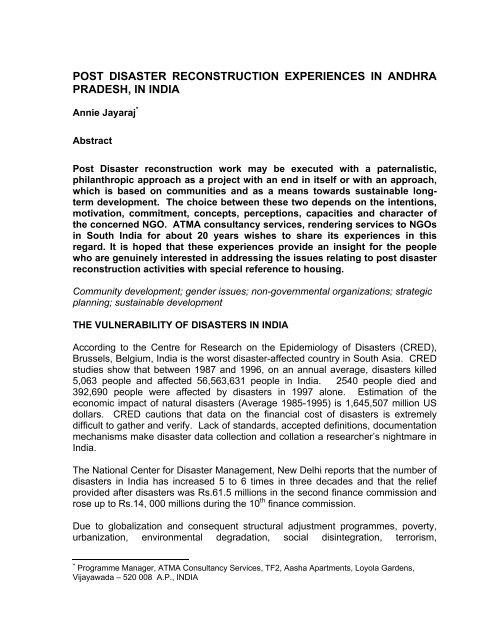


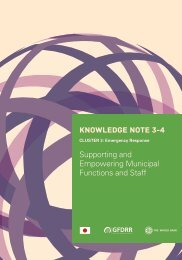
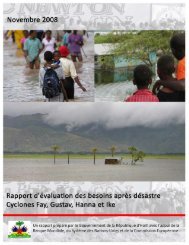
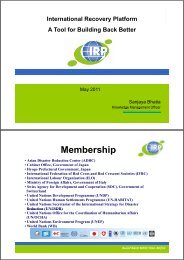
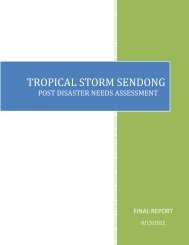
![View full document [PDF 7.65 MB] - unisdr](https://img.yumpu.com/48902806/1/178x260/view-full-document-pdf-765-mb-unisdr.jpg?quality=85)
